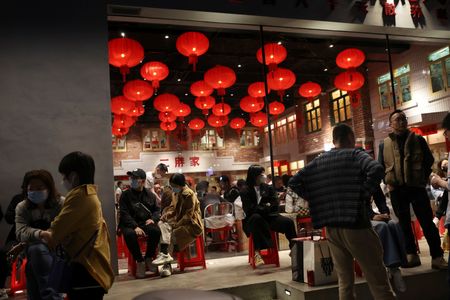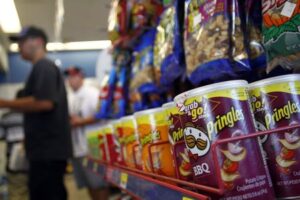(Reuters) – China’s economy contracted sharply in the second quarter while annual growth also slowed significantly, highlighting the colossal toll on activity from widespread COVID lockdowns, which jolted industrial production and consumer spending.
Gross domestic product fell 2.6% in the second quarter from the previous quarter, official data showed on Friday, compared with expectations for a 1.5% decline and a revised 1.4% gain in the previous quarter.
On a year-on-year basis, GDP in the April-June quarter grew a tepid 0.4%, missing forecast of a 1.0% gain, according to a Reuters poll of analysts, a sharp slowdown from 4.8% in the first quarter.
^^^^^^^^^^^^^^^^^^^^^^^^^^^^^^^^^^^^^^^^^^^^^^^^^^^^^^^^^^^^^^^
KEY POINTS
* Q2 GDP +0.4% y/y (f’cast +1%, Q1 +4.8%, H1 +2.5%)
* Q2 GDP -2.6% q/q s/adj (f’cast -1.5%, revised Q1 +1.4%)
* June industrial output +3.9% y/y (f’cast +4.1%, May +0.7%%)
* June retail sales +3.1% y/y (f’cast 0.0%, May -6.7%)
* Jan-June fixed asset investment +6.1% y/y (f’cast +6.0%, Jan-May +6.2%)
* Jan-June property investment -5.4% y/y (Jan-May -4.0%)
MARKET REACTION:
The CSI300 index rose 0.4% to 4,340.53 by 0221 GMT, while the Shanghai Composite Index gained 0.2% to 3,286.61. [.SS]
COMMENTARY:
MARCO SUN, CHIEF FINANCIAL MARKET ANALYST, MUFG BANK, SHANGHAI
“The disruption from COVID-19 on domestic economic activities was more pronounced this year. So, the quarter-on-quarter contraction in Q2 was well expected. Now that the pandemic is largely under control, economic activities are expected to gradually return to normal.”
“With domestic infrastructure investments starting to support the economy … I think the economy will have a soft landing this year.
LI WEI, SENIOR CHINA ECONOMIST, STANDARD CHARTERED, SHANGHAI
“Looking ahead, we expect China’s economy to pick up speed in the run up to the 20th Party Congress, on increased stimulus measures and easing COVID-19 control policies.”
“Friday’s Q2 GDP growth is very much in line with our forecast of 0.3% y/y. As a result, we maintain our GDP growth forecasts unchanged at 5.3% y/y for Q3, 5.9% y/y for Q4, and an average of 4.1% for the full-year 2022.”
“We keep our call of no more changes to the MLF (medium-term lending facility) rate or the RRR (reserve requirement ratio) until end-2023. The window for further policy rate cuts has likely closed due to the increasingly hawkish stance of major central banks, an uptrend in China’s CPI (consumer price index), and the likely economic recovery in H2. The authorities have limited room to continue to use the RRR as a regular liquidity injection tool.”
“In the absence of policy rate cuts, the PBOC (People’s Bank of China) is likely to increase the use of re-lending facilities and deposit rate reforms to influence future credit growth and corporate borrowing costs.”
“We expect the government to fully implement or even overshoot this year’s budget in order to maintain support for the economy amid continued impacts of COVID-19 containment measures and a slowing global economy.”
KEN CHEUNG, CHIEF ASIAN FX STRATEGIST, MIZUHO BANK, HONG KONG
“The downside pressure on the broad economy is huge. It is challenging to reach this year’s growth target. The authorities are likely to focus on target easing measures in the second half of this year. Given the ample liquidity in the banking system, chances for comprehensive easing are rather low.”
“Another big issue is the property sector, which may need more stimulus measures. We’ve seen reports about the unfinished housing projects, which have affected normal people’s daily lives.”
PEIQIAN LIU, CHINA ECONOMIST, NATWEST MARKETS, SINGAPORE
“The COVID-19 lockdown had quite a significant hit to China’s Q2 GDP growth, but then if you look at high-frequency June data, it’s suggesting that recovery is gaining some momentum, especially on the consumption side.”
“I still forecast annual growth at 4.1%, I don’t think Friday’s print is strong enough to change any of those forecasts.”
“The PBOC, in my view, is playing a coordinating and supporting role to fiscal easing, so there is still room for easing both in terms of liquidity injection and rate cuts but it’s likely to be moderate.”
WOEI CHEN HO, ECONOMIST, UOB, SINGAPORE
“The underlying June numbers show a fairly good recovery. The retail recovery is fast, compared with early part of 2020, when they took more than six months to go back to an expansion rate.”
“But, in terms of the second half, initially we were quite positive, but it seems they have more issues that are emerging. They continue to face challenges of COVID-19 resurgence. The property market offers greater pessimism and potential for crisis if they don’t manage it properly.”
“I don’t think in terms of monetary policy they can do a lot in terms of cutting interest rates … I think they will have to do more from the fiscal side, which is also proving to be a bit difficult because of a widening fiscal gap.”
RAY ATTRILL, CHIEF CURRENCY STRATEGIST, NATIONAL AUSTRALIA BANK, SYDNEY
“Obviously, GDP was a fair bit weaker than expected, and does nothing to suggest that the 5.5% whole-year growth target is remotely achievable.”
“From a market point of view, Q2 is already old hat. So, in terms of momentum, you’ve got retail sales picking up more sharply than people were anticipating as a result of various COVID-19 restrictions being lifted, and that’s probably the encouraging aspect of the numbers, and why it has been mildly supportive of the Aussie.”
“A toleration or encouragement of a weaker yuan is still something we expect in the second half of the year. Part of the reason is that China is losing competitiveness because of the weakness we’re seeing in the Korean won and the Japanese yen, for example.”
“China will not be happy to see this loss of competitiveness sustained, and so if — as we expect — the dollar is going to remain strong, then we think dollar-yuan is going to be headed up to between 6.75 and 7 in the second half of the year, and there’s nothing in Friday’s numbers that would dissuade us from that view.”
ZHANG ZHIWEI, CHIEF ECONOMIST, PINPOINT ASSET MANAGEMENT, SHENZHEN
“The economy likely bottomed in Q2. It is on track for a slow recovery. The rebound of retail sales is encouraging, and the strong credit growth indicates growth in Q3 will likely continue to recover. Nonetheless, economic growth is still much lower than its potential, as the fear of COVID-19 outbreaks continues to hurt consumer and corporate sentiment.”
“The slowdown in the property sector continues. This is worrying as the stress could spread to the financial sector and households if not managed properly and quickly. I expect the government will take action in Q3 to prevent the risk to spread.”
XING ZHAOPENG, SENIOR CHINA STRATEGIST, ANZ, SHANGHAI
“China will face huge pressure to reach this year’s growth target of around 5.5%, as President Xi Jinping has mentioned during his trip in Wuhan that China would rather endure some temporary impact on economic development than let the virus hurt people’s safety and health.”
“The authorities might have already rolled out all the supportive measures, (and) additional policy stimulus might be very limited.”
“Due to the low base effect, data from the next two quarters are likely to show signs of improvement. And I expect that the two-year average GDP in H2 could be around 5.5%.”
TORU NISHIHAMA, CHIEF ECONOMIST, DAI-ICHI LIFE RESEARCH INSTITUTE, TOKYO
“Infrastructure spending has led the growth and it will be a main driver of the Chinese economy ahead. There may be a talk of pent-up demand but you cannot count on private consumption to recover strongly given that household savings remain high.”
“China’s economy has stood on the edge of falling into stagflation, although the worst is over as of the May-June period. You can rule out the possibility of a recession, or two straight quarters of contraction.”
“Given the tame growth, China’s government is likely to deploy economic stimulus measures from now on to rev up its flagging growth, but hurdles are high for PBOC to cut interest rates further as it would fan inflation which has been kept relatively low at present.”
NATHAN CHOW, ECONOMIST, DBS, HONG KONG
“It was lower than expected, but a bit closer to our estimate of 0.9%. The retail sales jump is quite a surprise… I’m not sure if the strong rebound can last too long, given the fact that the job market is quite weak right now, especially youth unemployment.”
“Falling housing prices is another concern, especially to China because Chinese households hold a lot of real estate in their balance sheets — its a negative wealth effect. In the second half of the year, consumption may be stabilising but it’s not going to have a V-shaped rebound.”
“The bottom line is we’re still looking at fixed asset investment and infrastructure investment as the growth engine.”
SEAN CALLOW, SENIOR CURRENCY STRATEGIST, WESTPAC, SYDNEY
“There was limited FX reaction to the China data as there was something for everyone. The currently dominant bears will focus on the clear downside surprise on Q2 GDP, while optimists can note the clear recovery in June retail sales and industrial production.”
“The bears seem likely to remain in control, given the leap of faith needed to extrapolate from the June data. Offshore investors living with Omicron will remain sceptical that it is now clear sailing for China’s economy. We see scope for AUD/USD to slip to $0.6670 multi-day.”
BACKGROUND:
* China’s economy has started a tepid recovery from the supply shocks caused by wide lockdowns, although headwinds to growth persist, including from a still subdued property market, soft consumption and fear of any recurring waves of infections.
* Full or partial lockdowns were imposed in major Chinese cities from March through May, including the financial and commerce hub of Shanghai, jolting supply chains and economic activity.
* China has been ramping up policy support for the economy, although analysts say the official growth target of around 5.5% for this year will be hard to achieve without doing away with its strict zero-COVID strategy.
* Friday’s GDP data and June activity indicators come at a time of rapidly rising global interest rates to tackle surging inflation, stoking fears of a recession. The Ukraine war, which has fired up prices of a range of commodities, has renewed pressure on world supply chains in a blow to consumption.
* Against this backdrop, China’s key property market remains shaky and soft consumer spending at home mean its traditional engines of growth also remain underpowered. A renewed push on infrastructure spending will take time to get into gear.
(Reporting by Asian bureaus; Compiled & edited by Uttaresh.V)





